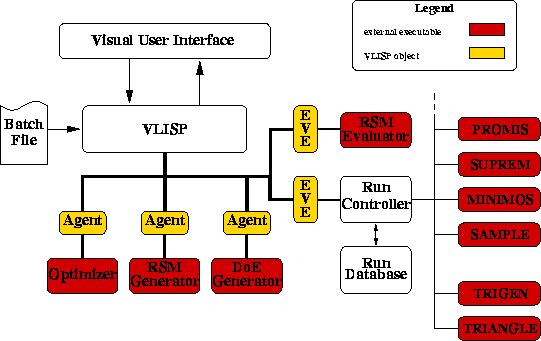
Figure 1: Overview of basic functional
components. Evaluable entities (EVE) provide a uniform
interface for computation requests, agents connect external
services with the framework. Both agents and EVEs are VLISP objects.
Fig. 1 shows the main functional components and their interactions. All communication between objects and between the framework and external executables works on an asynchronous basis to allow simultaneous control of a number of independent tasks within the simulation environment. The optimizer module [7] performs optimizations under non-linear constraints and nonlinear parameter estimations, the DoE module creates experiment inputs according to standard design schemes, and the RSM module generates and evaluates polynomial response surfaces of up to second order. Both the DoE and RSM modules support a number of transformations to adequately represent non-linear systems.

Figure 1: Overview of basic functional
components. Evaluable entities (EVE) provide a uniform
interface for computation requests, agents connect external
services with the framework. Both agents and EVEs are VLISP objects.
The run controller uses a process flow representation [6] to build the desired devices. It generates split trees and controls parallel computation of simulation jobs on the network. A number of framework tools provide gridding and geometry services to ensure data consistency and facilitate data exchange between different simulators. Note that both batch and interactive operations are fully supported. A batch file can be used to run complete analysis tasks over night, to customize the environment and to define new objects, or to load and initiate an analysis while monitoring and controlling it via the visual user interface.
The run database stores all data generated by simulation and maintains a dynamic split tree to avoid recomputation of existing data without forcing the user to adhere to a strict splitting scheme. Large output files are kept as such on the file system with only a pointer being entered into the database, extracted quantities, status information, etc. are directly written to the database. Great care has been taken to provide for a robust operation of the database to ensure error recovery without significant data loss even after severe error conditions.
The visual user interface is provided by the VLISP interpreter, which is linked with the Motif widget library. Some additional widgets not available in the current Motif distribution have been added to more efficiently support interactive operation.